Eleven Disappointing Replacement Heroes (and Their Better Alternatives)
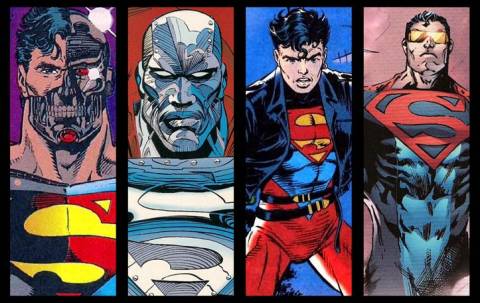 |
It’s become something of a long standing comic book tradition – famous super hero gets injured, crippled or even killed off, and is then replaced by a new hero wearing their famous name and costume, with the original hero eventually returning to the role after a series of struggles, not to mention fan demand for their return to their rightful place. One could say the whole concept of passing the superhero mantle to a newer,younger hero goes back to the fifties, when original Green Lantern Alan Scott and original Flash Jay Garrick let those new whipper-snappers Hal Jordan and Barry Allen take over their roles as Green Lantern and the Flash, respectively. Of course, there was a separation there of several years between Flashes and Green Lanterns, but still, you get the idea; new characters taking older heroic identities ain’t nothin’ new in comics.
But the trope really became popular (and overused) over the past twenty-five years or so, and is now something of a tired cliche. But as much as replacing iconic heroes is a cheap gimmick, let’s not forget superhero comics are nothing if not soap operas, and ongoing soap operas are full of gimmick storytelling. Doesn’t mean those some of those stories weren’t entertaining, or some of those gimmick characters didn’t grow into something more over time. As with all things…some gimmicks (and characters) are just cheaper than others. And some cheap gimmicks can last for years before they are undone. Case in point, our entry at #11…
11. Spider-Woman Julia Carpenter Replaces Spider-Woman Jessica Drew
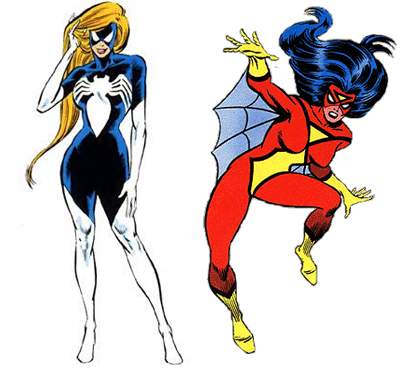 |
The original Spider-Woman, Jessica Drew, was created out of corporate need more than any other reason; at some point in the seventies, Stan Lee realized if they didn’t make a Spider-Woman spin-off character to their flagship hero Spider-Man, sooner or later another comic book company would take the name. So as a way of securing the copyright, Spider-Woman debuted in an issue of Marvel Spotlight in 1977. She was just meant to be a one-off character, created soley for that reason, but quickly Marvel saw potential in her, and within a year she not only had her own comic book series, but her own cartoon show on Saturday morning television.
Despite being created to be a female version of Spider-Man, much like Supergirl and Batgirl were female analogues of their popular DC Comics male counterparts, Spider-Woman ended up being an analogue in name only. Her origins, powers, and costume were totally different from Peter Parker’s, and aside from also living in the same Marvel Universe as Peter, had no other real connection to him. This was a much smarter and more interesting way to approach the character, as opposed to just making her a cheap knock-off of a popular male character (and before anyone flames me for that comment, no, I don’t think Supergirl and Batgirl are just cheap copies…but they did kind of start out that way). In the late seventies and early eighties, Spider-Woman was found on most products and merchandise featuring the Marvel icons, right alongside the Hulk and Captain America. She was clearly being positioned as Marvel’s top female hero.
Then, in 1983, after fifty issues of her own series and an earned place in the Marvel Pantheon, her series was abruptly cancelled and her powers and costumed identity removed. Rumor has it that Editor-In-Chief Jim Shooter thought a female version of Spidey (even though she really wasn’t at all) emasculated Spider-Man himself. This sounds ridiculous, of course, but the fact that Jessica Drew was all but erased from Marvel gives some validity to this rumor.
Nevertheless, Marvel needed to have a character named Spider-Woman floating around occasionally, otherwise they’d lose the copyright. So in the epic crossover miniseries Secret Wars, the same event that introduced Spider-Man’s new black costume, Marvel introduced Julia Carpenter, the new Spider-Woman. Although not a terrible character by any means – and with enough personality traits to not just make her a female counterpart to Peter Parker – the fact that her costume was identical to his, and her powers were far more similar to his as well, just made the the whole thing smell rotten, and well…a tad sexist. This version of Spider-Woman never carried her own ongoing series and was never fully embraced, leading to other characters taking up the name and mantle eventually.
The Better Replacement For Jessica Drew: Jessica Drew (Again)
So there were other replacement Spider-Women after Julia Carpenter, but none of them stuck around for too long either, because the truth was Marvel got the formula right the first time. In 2004, nearly twenty years after she was sent into comic book exile, Brian Bendis revived the original Jessica Drew Spider-Woman, original powers and costume intact. OK, OK, that version was really a Skrull agent in disguise, but we got the real Jess back in due time. And she is now once again a mainstay of the Marvel Universe and a high profile member of the Avengers.
10. Supergirl/Matrix Replaces Supergirl Kara Zor-El (1989-2002)
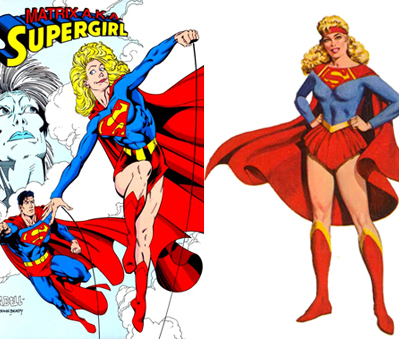 |
In 1985, DC ushered in their massive universe changing mini-series Crisis on Infinite Earths, which changed the mythology of most of their iconic heroes, including Superman himself. One of the new editorial mandates for Superman was that he was to be the only survivor of the planet Krypton from here on out. So no super dog, no super monkey, and no super cousin Kara either. Supergirl, a major DC heroine since her introduction in 1959, died heroically in Crisis #7. After the mini-series was over, and the new universe established, she was said to have never even existed in the first place. It probably didn’t help that her movie debut flopped badly the year before; if it had made a hundred million dollars it is highly doubtful DC would have killed her off.
But, much like Marvel’s Spider-Woman, DC had a copyright to protect. So in 1988, DC introduced an all new Supergirl…in the most confusing way humanly possible. This Supergirl was the Lana Lang from an alternate universe, with an Earth totally destroyed by an alternate General Zod. (A General Zod who was KILLED by Superman, by the way. Take that, all you ” but Superman never kills in the comics!” Superman II haters out there.) But it turned out that she wasn’t really Lana; she was the golem-like protoplasmic creation of a heroic Lex Luthor named Matrix, who could mimic Superman’s powers as well as shape shift. She came to our Superman’s universe, where she protoplasmically joined with a dying human girl named Linda Danvers, and eventually became an angel. Got all that? Although writer Peter David did his best with a Supergirl series featuring this version of the character, eventually DC realized she just was too confusing a character to make work long-term, and her series was cancelled after a respectable eighty issues.
Better Replacement Supergirl – Kara Zor-El (again)
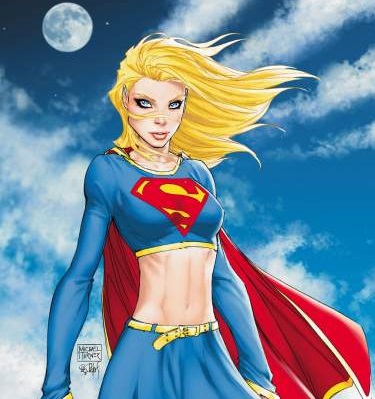 |
In 2004, DC decided the time was right to bring back the original Supergirl, cousin of Superman, in an all new incarnation. In a story arc in the Superman/Batman series, written by Jeph Loeb and drawn by the late Michael Turner, Supergirl was re-introduced to great fanfare and great sales. Although her origin was slightly tweaked, you could once again sum her up in one sentence: “Superman’s cousin from Krytpon.” Sometimes, simpler is better.
9. John Walker Replaces Steve Rogers as Captain America (1986-88)
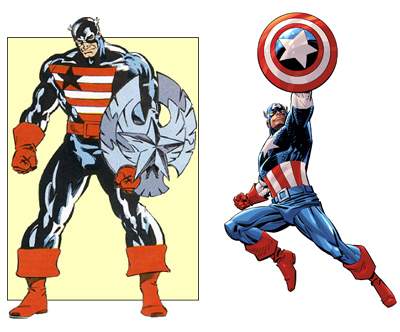 |
Before Superman, Batman or Spider-Man, one of the most well known replacement hero storylines happened to Captain America. Back in 1986, under writer Mark Gruenwald, Steve Rogers resigned as Captain America, due to not wanting to represent the United States government itself anymore, but instead simply represent the country’s ideals. Noble enough, right? So Rogers started to refer to himself simply as “the Captain,” and wore a new red, white and black version of his costume. Of course, the United States government found their own person to fill Cap’s boots and do their bidding for them. The replacement Cap they found was John Walker, a former Marine from Custer’s Grove, Georgia, who had once gone by the name of Super Patriot. Receiving his powers not from the United States military but from a shady guy called the Power Broker, Walker nevertheless got the Captain America gig when Steve Rogers left the role.
Series writer Mark Gruenwald made this new Cap a liberal’s nightmare version of extreme conservatism: jingoistic, xenophobic, and far more prone to violence than reason, this was a Captain America more than willing to kill his enemies. In many ways, this Cap was way more Punisher than boy scout, a kind of answer to those who said Cap’s ways reflected an outdated morality from a bygone era. Of course, Steve Rogers would eventually reclaim his good name from this interloper after a little more than a year, but that wouldn’t be the end of John Walker; he would soon start wearing the red white and black costume worn by Steve Rogers when he was going by “the Captain,” and changed his name to the U.S. Agent. And in some form or another, U.S. Agent has been a part of the Marvel Universe ever since.
Better Replacement Captain America – Bucky Barnes (2007-2009)
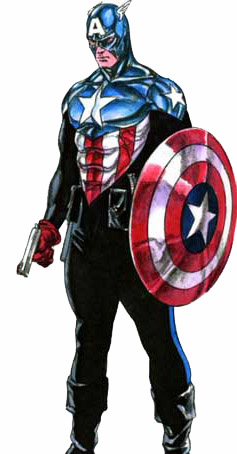 |
In comic book heaven, there aren’t so much pearly gates at the entrance as there are revolving doors. Still, even with that fact in mind, for many years there were certain deaths in comics that were considered to be sacred: Jason Todd, the second Robin (we’ll get to him); Barry Allen, the second Flash; the original Supergirl; and Captain America’s kid partner from World War II, Bucky Barnes. Bucky died in the 1940s, and was constantly referred to by the modern-era Captain America as the greatest tragedy of his younger days.
But then in 2005, after some sixty years of being dead, writer Ed Brubaker brought Bucky back to the land of the living as The Winter Soldier in a very well received storyline, considered to be one of the greatest Captain America stories of all time (it’s the basis for the next movie for a reason). The Winter Soldier was so popular, in fact, that when Steve Rogers “died” (remember what I said about comic book heaven) after the end of Marvel’s Civil War crossover, Winter Soldier ended up taking up the mantle of Cap for a period of almost two years, and fans, for the most part, loved it. After all, who better than Bucky to take up the shield of Cap? His costume was more “Captain Puerto Rico” than Captain America, though. Someone should have thought that one through a bit more.
8. Artemis Replaces Princess Diana as Wonder Woman (1994-95)
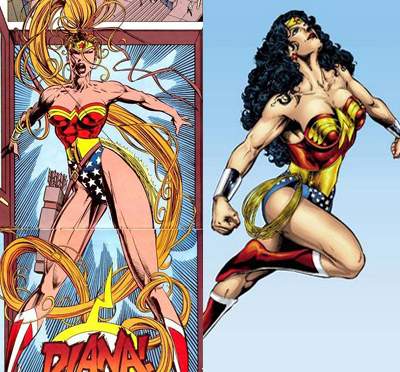 |
After the success, financially anyway, of the replacement hero stories with Superman and Batman in the previous two years, it was only a matter of time before DC tried to do the exact same thing with Wonder Woman. In 1994, around the time the Zero Hour crossover mini-series was going on, writer William Messner Loebs and then-hot new artist Mike Deodato did a year long story where Wonder Woman’s mother, Queen Hippolyta of the Amazons, decreed that her daughter Diana had failed in her mission as Wonder Woman, and that a new contest would be held among the Amazons to find a new ambassador to man’s world, and therefore a new Wonder Woman. The winner of the contest was Artemis, an Amazon from a savage tribe of Amazons called the Bana-Mighdall.
This Wonder Woman was way more savage and “extreme” – this was the nineties after all, and everything was more extreme, including her ridiculously long ponytai l- and had a far worse attitude than our nice and usually cheerful Diana. Aside from having more attitude, she was also far more sexualized, as Diana’s famous star spangled granny panties now became the wonder-thong. Artemis eventually softened her rough edges over her year long stint as Wonder Woman, and then of course Diana returned to the role and Artemis died tragically. This being comics, the whole death thing lasted less than a year. Later, better stories from creators such as Phil Jimenez and Greg Rucka made Artemis a more interesting and well rounded part of the Wonder family, but during her actual stint as Wonder Woman, she was kind of just a walking ’90s cliche.
Better Replacement Wonder Woman – Queen Hippolyta (1997-1998) and Donna Troy (2006)
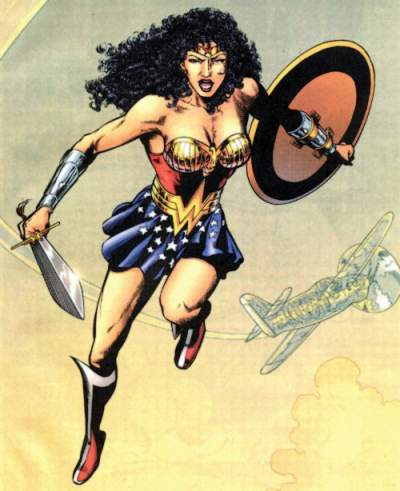 |
Wonder Woman wasn’t only out of commission that one time – in the late ’90s, Diana was elevated to Goddess of Truth on Mount Olympus, and her mother became the new Wonder Woman in her place. Not only did she become the new Wonder Woman, but she traveled back in time to the 1940’s to become the Wonder Woman of the Golden Age, restoring all those classic stories to continuity once again. Diana’s sister Donna Troy also briefly replaced her in 2006, at a time when Diana was taking time off to “find herself.” Her time wasn’t all that memorable, but there wasn’t an outcry when she took over the role; after years as Wonder Girl, to fans, she felt like she had earned it.
7. Eric Masterson Replaces Thor as “New Thor.” (1991-93)
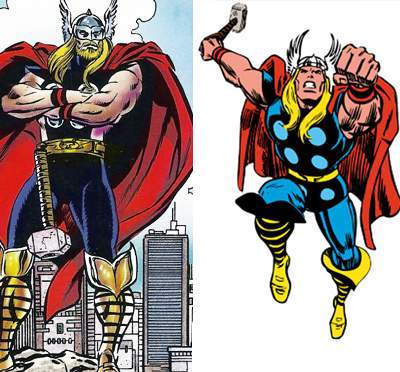 |
How do you successfully replace a superhero who isn’t just a superhero, but a friggin’ God? The answer: You don’t, not successfully. Back in the early ’90s, the Avengers brand wasn’t quite the powerhouse it was today, as all of Marvel’s attention was on X-Men and Spider-Man titles, and all their various spin-offs. In an effort to spice things up in the pages of Thor, the writers had the title character replaced by Eric Masterson, an architect and, conveniently, also a Nordic, tall, blonde dude. At first, Masterson merged with Thor in a similar way that Dr. Donald Blake merged with him in his original ’60s incarnation, but eventually he was proven worthy as being the new Thor when the real one was punished for killing Loki. Spoiler Alert: Loki got better.
Masterson actually lasted as Thor for a while, nearly two years, before Marvel caved in to fanboy demands and brought back the original God of Thunder to the book. Masterson was given his own hammer created by Odin called “Thunderstrike,” which he would name himself after, while more or less operating as “Thor Jr.” for a few years. He even had his own title, back when every major Marvel property tried to go the franchise route. Eventually Thunderstrike would just prove to not be anything but redundant with the real Thor around, and he was killed off and his book canceled.
Better Replacement Thor: None. (Okay, maybe Beta Ray Bill)
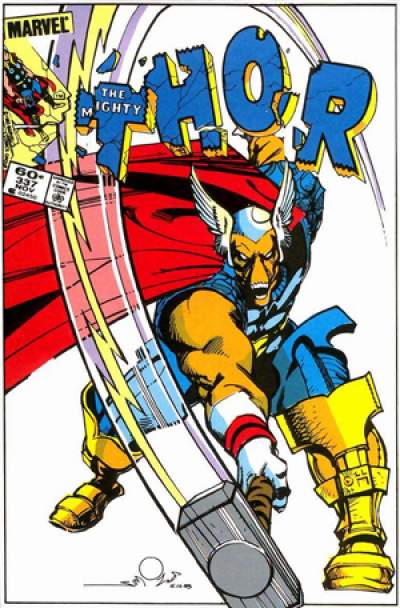 |
Thor isn’t just a super hero name or title, it’s how the character is. He can’t be replaced, at least not in a way that doesn’t come off as lame. But I will concede that it was kinda cool when he was “replaced” once, in a sense, by an alien horse like creature named Beta Ray Bill, the first being in Thor’s then-two decade publishing history with the worthiness to pick up and use Mjolnir, Thor’s hammer. Beta Ray Bill was so bad ass, Odin forged him his own hammer, called Stormbreaker. A weird looking alien guy is always going to be a cooler “second Thor” than some guy who looks just like the original, but is an architect and not an Asgardian God.
6. Ben Reilly Replaces Peter Parker as Spider-Man (1994-96)
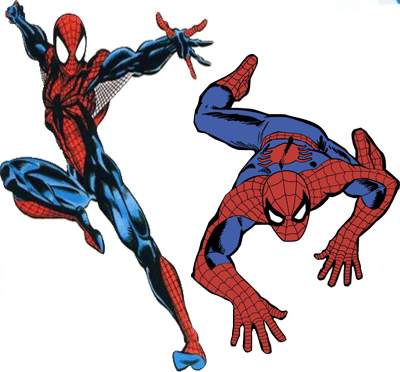 |
Spider-Man is easily one of the most recognizable super hero icons on Earth, right up there with Batman and Superman. So everyone knew replacing him with anyone else was going to be controversial, because Spidey is just so beloved. Also, everyone knew with an icon that huge, it would only be a matter of time before the original version of Spidey returned, so how could Marvel actually convince fans that this replacement was maybe more than just temporary? By replacing him with another version of himself, that’s how.
Ben Reilly, otherwise known as “The Scarlet Spider” or worse, “The Spider-Clone,” was first briefly introduced in the mid ’70s in an issue of The Amazing Spider-Man, as a clone created by Dr. Miles Warren, a.k.a. The Jackal. He only appeared in two issues, where at the end he was thought to have been killed off. But then, nearly twenty years later, in one of the biggest retcons in comics history, it was revealed that the clone Peter had survived, and spent the last several years, as Jules from Pulp Fiction would say, “walkin’ the Earth.” He used the assumed name of Ben Reilly (after his Uncle Ben of course) and stayed away from superheroics, keeping his existence a secret.
Eventually though, after five years (in fact, twenty years real time) in hiding, Ben returned to being a super hero as The Scarlet Spider, which begins the two year long ordeal known as “The Clone Saga.” Once Scarlet Spider returned, it wasn’t long before (dun Dun DUN!) it was revealed that the Peter Parker we’d known and loved since 1975 was in fact the clone, and Ben was the “real” Peter. This gave Marvel what they’d been craving for years at that point, an unmarried Spider-Man. Peter and Mary Jane went off to start a family, and Ben Reilly was now officially Spider-Man, in an all new costume to boot.
To say that fans hated the idea that the version that they had grown up loving and reading about faithfully for years was a fake is an understatement. Despite initial strong sales, by the end of this two year long ordeal, the Clone Saga became synonymous with bad storytelling and stunts, and sales plummeted. By the end of 1996, it was revealed that Ben Reilly was the clone like we had all thought he was in the first place, and Peter Parker returned to the role once more. Ben Reilly died, and unlike most comic book deaths, this one stuck, probably due to the fact that everyone disliked him so, or more to the point, disliked the whole story that he represented.
Better Replacement Spider-Man – Doc Ock (2013-Present)
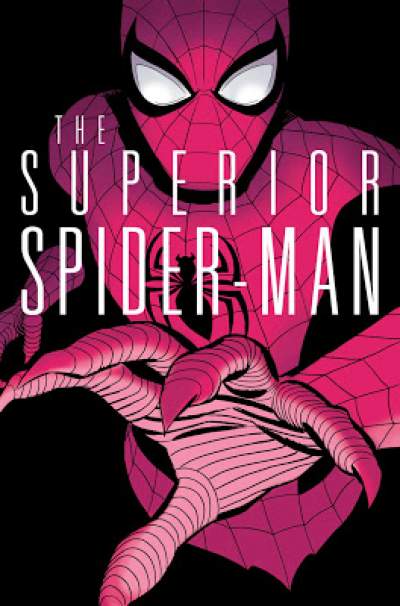 |
History is repeating itself as we speak, because right now the current Spider-Man isn’t Peter Parker at all, it’s Doc Ock, in the pages of The Superior Spider-Man. Well, it’s Peter’s body, but it’s Doctor Octopus’ soul occupying it, while Peter’s has gone on to the great beyond with Uncle Ben. Instead of being pure evil, however, the weight of Peter’s memories and heroism has weighed heavily on the good doctor, who has turned over a new leaf and become a hero himself, although he’s still a surly asshole. This is a much more interesting replacement than just a clone, and while it is only a matter of time before the real Peter returns, fans are enjoying the ride this time.
5. Bart Allen Replaces Wally West as The Flash (2006-2007)
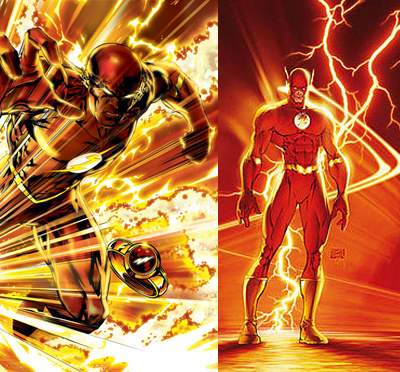 |
When Wally West, the former Kid Flash, took over from his mentor Barry Allen as the Flash after his death in 1985’s Crisis on Infinite Earths,very few people complained. After all, he’d earned his little helmet wings, having been the Flash’s kid partner for over twenty-five years at that point, not to mention one of the main members of The New Teen Titans, DC’s most popular team book. Wally’s version of the Flash eventually got his own kid partner, when his cousin Bart Allen (the second Flash’s grandson) arrived from the future and took the name Impulse. Bart was basically an even spazzier version of a young Wally who got his own ongoing series and was a member of Young Justice, and later in the early 2000s joined the Teen Titans as Kid Flash II. But while he was a well-liked character, he was portrayed as no more than fifteen years old at most. So when DC did Infinite Crisis in 2005 as a sequel to the original Crisis, they wanted to recreate one of that series’ most iconic moments – the death of the Flash. Unfortunately, they half-assed it royally.
Instead of sticking to their guns by going all the way and actually killing Wally off, they had him disappear into the Speed Force, the source of energy from which all speedsters in the DCU got their powers. And through various convoluted means, they grew Bart into instant adulthood and had him become the fourth hero to wear the mantle of the Flash. He was quickly rewarded with his own title, Flash: The Fastest Man Alive. But although readers loved Bart as Kid Flash, forcing him into the role of an adult hero just for the sake of change just read as forced to everyone. Despite initial strong sales, the general sentiment from fandom was “we want Wally back. Now.” Reaction was so bad to this new Flash that within less than a year, he was killed off, and Wally West came back from the Speed Force to replace his younger cousin. Bart Allen would eventually return, de-aged back to teenagehood again, and everyone was happy. That is, until the New 52 reboot took Wally away again and screwed it all up.
Better Replacement Flash – Barry Allen (2008-Present)
I’m not sure “better” is the word to use here, because I still think Wally West was and is a more interesting and well-rounded character than Barry Allen ever was. In 2008, after twenty-three years of being dead and gone and serving the role of the Justice League’s patron “St.Barry,” DC decided to bring back Barry Allen, possibly the last of comicdom’s “sacred deaths” to be undone. Wally wasn’t technically replaced, but Barry was now the main Flash again, and Wally was now relegated to cameo player. Writer Geoff Johns did his best in the Flash: Rebirth mini-series to make Barry interesting, if only because he was now DC’s equivalent to Captain America, a “man out of time” so to speak. Barry’s time traveling in the Flashpoint mini-series is what led to the New 52 universe (which is Wally free) so maybe I just resent him a little. Still…if anyone had earned the right to replace Wally West as the Flash, I suppose it was the character who inspired Wally in the first place.
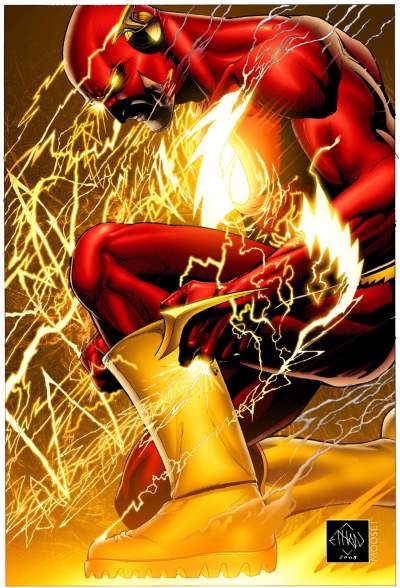 |
4. Guy Gardner Replaces Hal Jordan as Green Lantern (1986-1990)
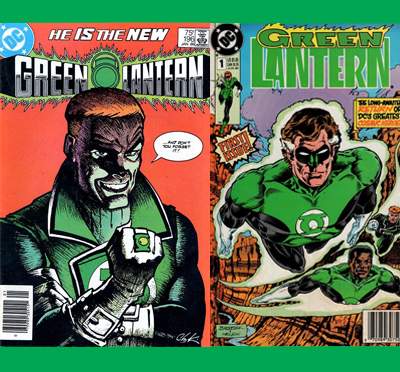 |
When a hot-headed angry ginger named Guy Gardner replaced Hal Jordan as the Green Lantern of sector 2814, it wasn’t the first time he’d been replaced as the main Lantern of Earth, as John Stewart had replaced him previously for various stints, some even lasting as long as a year. But when Gardner replaced Hal Jordan as Green Lantern, he replaced him not only in his own book, but in the pages of the Justice League as well. Hal still appeared in Green Lantern Corps, as one of a team of many Lanterns. But at DC, the highest profile GL was easily Gardner for the better part of the late ’80s and into the early ’90s.
So while Hal wasn’t exactly replaced…he was certainly demoted. Even when Green Lantern Corps was canceled, and Hal Jordan got his solo title once more, it wasn’t entirely solo, as he alternated story arcs with John Stewart and Guy Gardner, simply because Guy was more popular. Early ’90s Guy was simply more liked overall than the mopey, gray haired Hal Jordan at this point. The problem here being that DC had now made their most popular Lantern a total jerk, with anti-social tendencies and really stupid hair. In hindsight, maybe not their smartest decision.
So Hal was then pushed back into prominence, and Guy was given a yellow power ring like Sinestro’s. He wasn’t Guy Gardner: Green Lantern anymore, he was just plain old Guy Gardner (and later Guy Gardner: Warrior, but let’s pretend that never happened.) But despite being pushed to the forefront once more, people still viewed Hal as a relic of the sixties. So DC sought out yet another character to replace him. And for the most part, this one worked out.
Better Replacement Green Lantern – Kyle Rayner (1994-2004)
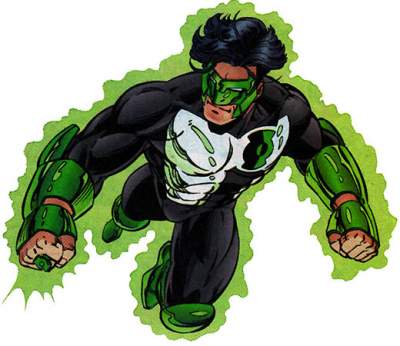 |
In an effort to make Hal Jordan “interesting” for ’90’s comic book fans, the editors at DC decided to take a stalwart hero and DC Comics icon since 1959…and make him crazy and kind of evil. His hometown of Coast City was destroyed when he was out in space (hence the “crazy”) and he decided to take the power of the rest of the Green Lantern Corps and the Guardians of the Universe themselves, mowing them down till he had enough power to restore his city again (hence the “evil.”) He became the villain Parallax, and a new Green Lantern was chosen – artist and slacker Kyle Rayner, who received the ring from the last Guardian in an alley outside a night club while wearing a Nine Inch Nails t-shirt. The hope was that a new, young Lantern (who wasn’t a dick like Guy Gardner) would connect with audiences, since he was meant to reflect the main readership of comics – guys in their teens and twenties.
And for all intents and purposes, it worked. Kyle was well-liked, and being an artist, the editors at DC thought his energy constructs would be more interesting than Hal’s, so they let their imaginations run wild. He was also the Lantern for Grant Morrison’s now-classic run on JLA. But while Kyle as character was likable enough, the writers on the book had a hard time creating villains or love interests for Kyle than didn’t already come from the already existing DC Universe. What Kyle was missing was the overall mythology that Hal Jordan had. So in 2004, writer Geoff Johns finally cracked the nut that was Hal Jordan to enormous success, elevating him to the highest ranks of the DCU once more. The rest is history, as they say, but it shouldn’t be forgotten that Kyle Rayner was more than just a cheap replacement; he was the one and only Green Lantern for a decade, with much of that decade with strong sales and positive fan reaction.
3. Azrael Replaces Batman (1993-1994)
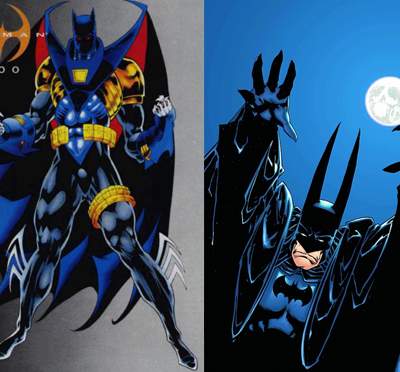 |
In the wake of the massive sales success of The Death and Return of Superman storyline in 1992/93, it was only natural that DC Comics would try a similar stunt with their other most iconic hero, Batman. Of course, just killing off Batman wouldn’t quite work, as Bats has no super powers with which to easily explain a return to the land of the living. Instead, Batman’s back was broken by then-brand-new villain Bane in the Knightfall crossover event that ran through all the Batman family titles. The whole “breaking the Bat” angle instantly sealed Bane as an A-list Batman villain, which was a pretty tough club to get into. (think about it: most of the A-list Bat bad guys were created in the forties; of all the new Batman villains introduced in subsequent years, you got maybe one who really made it to star status for every subsequent decade.) Bane’s role in breaking Batman’s back and being the first villain to truly physically defeat him would eventually form a huge part of the structure to The Dark Knight Rises.
With Batman out of commission, he turned to Azrael, another recent addition to the Batman mythos. Azrael was really Jean-Paul Valley, an assassin for the Order of St. Dumas. He was being trained by Batman as a crime-fighter at the time that Bruce Wayne was crippled, so he took over the role of Batman for him, all while wearing a very over-designed and ugly new costume. Of course, this Batman was more Punisher than Batman, and he allowed a criminal he was fighting to die, which inadvertently allowed one the criminal’s innocent victims to also be killed. An outraged and now all-fixed up and mended Bruce Wayne returned to reclaim his title, and finally the real Batman was back. Valley became Azrael once more, and I guess was popular enough to get his own title that lasted an impressive 100 issues. He was killed in that final issue, and somehow was never brought back to life since.
Better Batman Replacement – Dick Grayson (2008-2010)
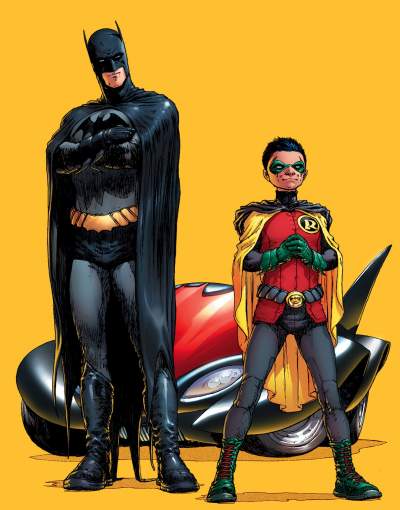 |
The question every fan had when Batman was incapacitated by Bane was “why didn’t Dick Grayson just take over as Batman?!?” After all, by this time he had abandoned his role as Robin to be the adult hero Nightwing for almost a decade. He had proven himself, and fans loved him. After Azrael, Dick was Batman for a short period of time in the story called Prodigal, but it was fairly short lived. However, when Batman “died” after the event mini-series Final Crisis, Dick successfully took over the role of the Dark Knight for over a year, and produced a ton of good stories to boot, including Grant Morisson’s Batman & Robin run, as well as Scott Snyder’s story The Black Mirror.
2. Jason Todd replaces Dick Grayson as Robin (1983-1988)
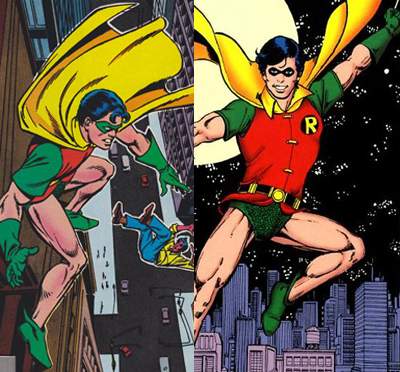 |
Possibly the first and biggest superhero replacement in comics was when Batman got a new partner in the form of Jason Todd, who replaced Dick Grayson after 44 years of the latter’s being Robin the Boy Wonder. Dick Grayson had a major character renaissance in the early eighties, as the leader of the New Teen Titans, DC comics’ biggest selling title. In the span of just a few years, the former butt of jokes went from being a “Holy ____ Batman!” laughing stock to a capable fighter, detective, and leader all his own. He also was dating a gorgeous alien girl with giant boobs and a healthy sexual drive. All while wearing little green short shorts and pixie boots: no small feat.
The Titans editorial office was wanting more and more control over Dick Grayson ,but he ultimately was still supposed to be a Batman character. So a compromise was made – Dick Grayson would graduate to the role of a new superhero, called Nightwing, and Batman would get an all-new Robin. Problem was, stepping into an iconic role like Robin’s was no easy task. From almost the beginning, fans just hated poor Jason Todd.
Jason was originally a kid from a family of circus performers whose parents were killed -the exact same origin as Dick Grayson’s. It was really unoriginal, and DC used the Crisis on Infinite Earths continuity change a couple of years later to change Jason’s origin yet again, this time as a street orphan who Batman adopts after trying to steal the hubcaps off the Batmobile. As part of the effort to make him as different as possible from Dick, the writers went too far; this version of Jason was a snot, talked back to Batman, and even broke the Bat’s cardinal rule #1…letting a criminal die. And the worse he got, the more fans hated him. People were wondering if a kid partner in a little yellow cape was even needed in the grim n’ gritty ’80s. So DC put the death of Robin up to a vote (via 900 number) and the fans voted for him to die.
Better Replacement – Tim Drake (1989-2009)
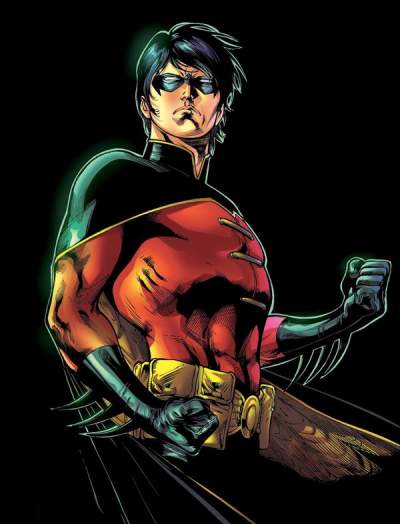 |
Jason Todd wasn’t even cold yet when DC decided that Batman needed a Robin again; he was just too much of an overall part of the mythos to keep dead. But this time, they were careful, and when they created Robin III with an upgraded costume in the form of Tim Drake, they created a character who was as smart (if not smarter) than Dick Grayson, but fortunately didn’t have any of the bad attitude of Jason and knew better than to talk back to Batman (well, until he earned it) This time, fans embraced Robin, and he was awarded his own ongoing series – the first Robin ever to have one.
1. Four Different Characters Replace Clark Kent as Superman (1993)
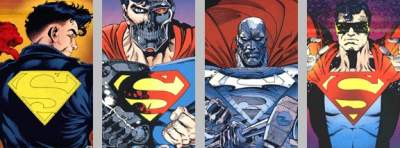 |
There is perhaps no better known “superhero replacement story” than DC Comics’ Reign of the Supermen, which ran through the four Superman titles at the time in 1993: Superman, Action Comics, Man of Steel, and Adventures of Superman. In fact, the entire Death and Return of Superman saga was really nothing more than a massive sales gimmick, but it was an extremely well done and engaging gimmick story that kept the fans coming back week after week for a solid year, maybe the biggest year in terms of sales that the character of Superman had ever had. Certainly, Superman had not sold millions of comics like that in decades. And it all happened simply because DC editorial was forced to postpone the wedding of Lois Lane and Clark Kent, and had to come up with something…anything to replace it.
In the early ’90s, Warner Brothers was developing a television version of Superman called Lois & Clark, one that would focus on the courtship and eventual marriage of Clark Kent and Lois Lane. DC was already planning for Lois and Clark to be married in the Fall of 1992, but since Warners wanted corporate synergy, the wedding was put on hold so the comic book and television versions could happen at the same time (which is eventually what happened in 1996.) So, with their wedding plans foiled, Superman editor Mike Carlin decided “why don’t we just kill ‘im?”
Although it was in no way ever meant to be permanent, the news media ate the story of the death of Superman up, and bought the line that DC was killing off their biggest icon “because no one appreciated him anymore.” In truth, Superman was still easily one of DC’s biggest selling comics at the time, but the news media’s ignorance of comic book tropes played in DC’s favor, as newspapers and magazines all over the country ran stories about the death of an American icon and the end of an era, and media exposure caused massive sales for Superman again.
So Superman was killed by the alien monster Doomsday, and stayed dead for maybe three months. Then, DC unleashed their ultimate gimmick – four new heroes all claiming the name and title of Superman would emerge, asking the readership to guess who among them was the real deal. There was the Cyborg Superman (“the Man of Tomorrow”) the Iron Man-like “Man of Steel,” the alien-like “Last Son of Krypton,” and finally the Metropolis Kid, who was essentially the new Superboy. All of these new Supermen debuted to much fanfare, and the storyline featuring them was called The Reign of the Supermen.
Of course, none of them was the real deal: the real Superman eventually rose from the grave and reclaimed his mantle. But the overall year-long story was insanely addictive, coming out in weekly installments, like comic book crack. By the end of it all, Superboy and the Man of Steel (now just known as “Steel”) would become important additions to the DC Universe, and Doomsday would become the most important new Superman villains in decades. Even the Cyborg Superman would become a major new player in the Superman mythology, as a villain. And the original Superman would return, more popular than he had been in many years. A story conceived when the writers ran out of ideas proved to be one of the most read Superman stories of all time.
Better Replacement Superman – Nobody. Because He’s Superman.
Seriously, Superman is (even with other Kryptonians out there) one of a kind. If the whole Reign of the Superman story proved anything, it’s that the big blue boy scout is truly irreplaceable.
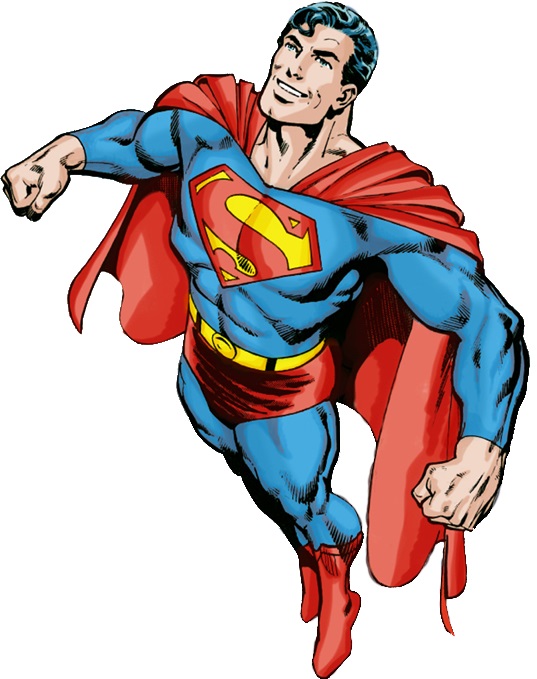 |


